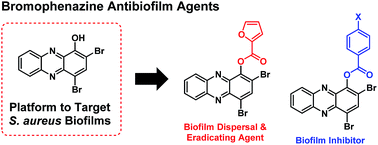Bromophenazine derivatives with potent inhibition, dispersion and eradication activities against Staphylococcus aureus biofilms†
Abstract
Bacterial biofilms are surface-attached communities of bacteria that are: (1) highly prevalent in human infections, and (2) resistant to conventional antibiotic treatments and host immune responses. It has only been in the last ∼20 years that bacterial biofilms have been identified as a critical biomedical hurdle in infectious disease and human health. Staphylococcus aureus is a leading cause of nosocomial and community-acquired infections and is notorious for its ability to form drug-resistant biofilms. Despite the need for antibacterial agents that target S. aureus biofilms, few chemical scaffolds are known that are capable of inhibiting, dispersing or eradicating their biofilms. Here, we report the discovery of bromophenazine derivatives that display antibiofilm activities as either potent biofilm inhibitors (IC50 values 0.55–10.3 μM) or dispersal agents (EC50 values 1.4–29.3 μM) and biofilm eradicators (MBEC values 100–200 μM) against S. aureus strains, including a methicillin-resistant Staphylococcus aureus clinical isolate. These discoveries could lead to the development of new treatment options that target drug-resistant, biofilm-associated S. aureus infections.


 Please wait while we load your content...
Please wait while we load your content...